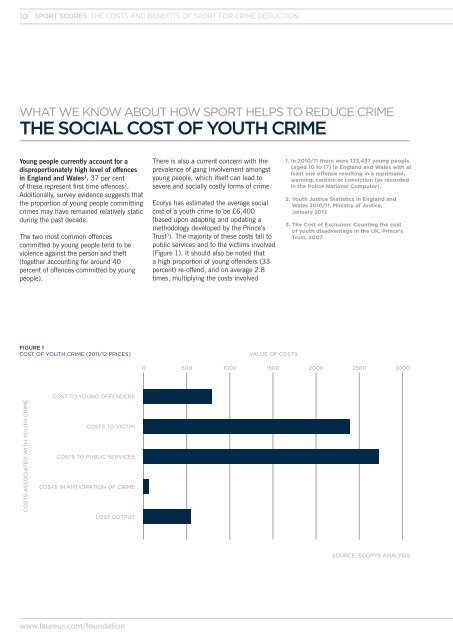Report: Sport Scores - Ecorys UK
Report: Sport Scores - Ecorys UK
Report: Sport Scores - Ecorys UK
You also want an ePaper? Increase the reach of your titles
YUMPU automatically turns print PDFs into web optimized ePapers that Google loves.
10<br />
<strong>Sport</strong> ScoreS: the costs and benefits of sport for crime reduction<br />
What We knoW about hoW sport heLps to reduce crime<br />
11<br />
What We knoW about hoW sport heLps to reduce crime<br />
tHe SociaL coSt oF youtH crime<br />
riSK aND<br />
protectioN FactorS<br />
young people currently account for a<br />
disproportionately high level of offences<br />
in England and Wales 1 . 37 per cent<br />
of these represent first time offences 2 .<br />
Additionally, survey evidence suggests that<br />
the proportion of young people committing<br />
crimes may have remained relatively static<br />
during the past decade.<br />
The two most common offences<br />
committed by young people tend to be<br />
violence against the person and theft<br />
(together accounting for around 40<br />
percent of offences committed by young<br />
people).<br />
There is also a current concern with the<br />
prevalence of gang involvement amongst<br />
young people, which itself can lead to<br />
severe and socially costly forms of crime.<br />
<strong>Ecorys</strong> has estimated the average social<br />
cost of a youth crime to be £6,400<br />
(based upon adapting and updating a<br />
methodology developed by the Prince’s<br />
Trust 3 ). The majority of these costs fall to<br />
public services and to the victims involved<br />
(Figure 1). It should also be noted that<br />
a high proportion of young offenders (33<br />
percent) re-offend, and on average 2.8<br />
times, multiplying the costs involved<br />
1. In 2010/11 there were 123,437 young people<br />
(aged 10 to 17) in England and Wales with at<br />
least one offence resulting in a reprimand,<br />
warning, caution or conviction (as recorded<br />
in the police National Computer).<br />
2. youth Justice Statistics in England and<br />
Wales 2010/11, Ministry of Justice,<br />
January 2012<br />
3. t he Cost of Exclusion: Counting the cost<br />
of youth disadvantage in the uK, prince’s<br />
trust, 2007<br />
Many of the young people engaged by<br />
crime reduction sport projects, though<br />
considered ‘at risk’, may not have been<br />
involved in recorded youth crime. Early<br />
behavioural problems can nonetheless<br />
provide an indicator of future criminality<br />
- a study of three countries for example<br />
found that, for boys, physical aggression<br />
at the age of 5-7 (as reported by the<br />
teacher) was associated with both violent<br />
and non-violent forms of offending in<br />
adolescence.<br />
In particular, exclusion from school can<br />
accelerate or increase the likelihood of<br />
criminal and anti-social behaviour in later<br />
teenage years. 4<br />
In the absence of any prior involvement in<br />
serious youth disorder, the measurement<br />
of significant changes in risk factors<br />
for crime (and associated protective<br />
factors) can provide a suitable alternative<br />
indication of success for crime reduction<br />
projects. In addition to measuring<br />
reductions in re-offending, this study<br />
also adopts an innovative approach to<br />
assessing predicted reductions in crime<br />
amongst non-offenders, by measuring<br />
changes in risk and protection 5 .<br />
FiGure 1<br />
cost of youth crime (2011/12 prices)<br />
vaLue of costs<br />
0 500 1000 1500 2000 2500 3000<br />
costs associated With youth crime<br />
cost to younG offenders<br />
costs to victim<br />
costs to pubLic services<br />
costs in anticipation of crime<br />
Lost output<br />
LAuREuS AMBASSADOR MARCuS ALLEN IN A WORKOut SESSION At<br />
KICK IM BOxRING pROJECt IN GERMANy<br />
source: ecorys anaLysis<br />
4. t he chance of a lifetime: preventing early<br />
conduct problems and reducing crime,<br />
Sainsbury’s Centre for Mental Health, 2011<br />
5. t he methodology is based upon validated<br />
research undertaken by the university<br />
of Oxford (Role of Risk and protective<br />
Factors, youth Justice Board, 2006)<br />
www.laureus.com/foundation<br />
www.laureus.com/foundation








